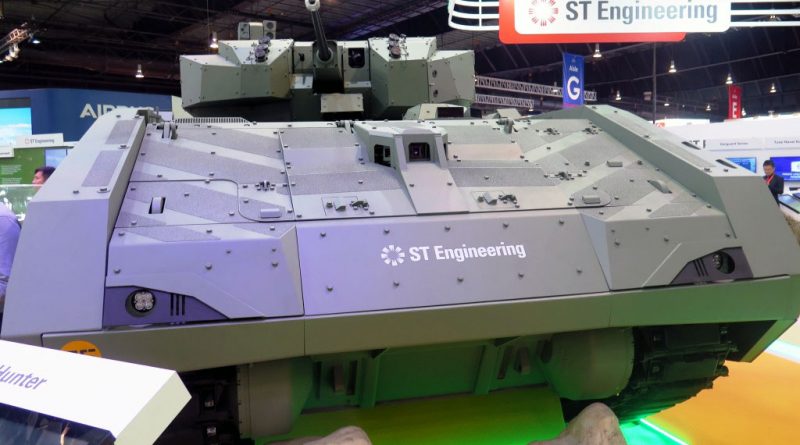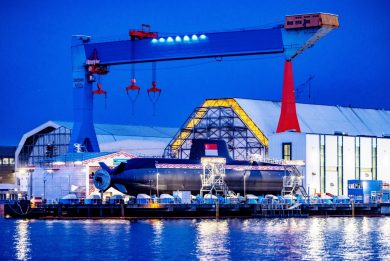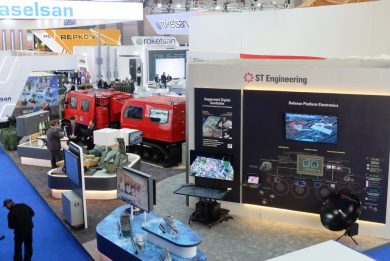ST Engineering Hunter IFV close to become operational
While the Singapore Army is receiving its first Hunters, the new armoured infantry fighting vehicles, produced by ST Engineering Land Systems, that will soon replace the ageing Ultra M113 of which over 700 are still currently in service, new details emerge on what will become the frontline vehicle of the Army mechanised formations. Not to forget that the Singapore Army also fields around 300 Bionix IFVs. Compared to that vehicle the new one has a combat weight over 6 tonnes higher, 29.5 versus 23 tonnes, however according to company officials the mean maximum pressure is similar to that of the Bionix, allowing the Hunter to maintain maximum mobility in the tropical terrain typical of the Far East. Compared to the Bionix the Hunter is longer, 6.9 versus 5.9 meters, the greater length of its tracks compensating the increased weight when considering the mean maximum pressure. The vehicle is rated MC 35 as far as bridge crossing is concerned, the Hunter being 3.4 meters wide and 3.4 meters high at the turret top.
To maintain a 24 hp/t power-to-weight ratio the Hunter is fitted with an MTU 8V-199 TE20 diesel turbocharged engine providing 720 hp (530 kW) at 2,300 rpm, with a maximum 2,700 NM torque at 1,500 rpm. The engine is coupled to an HMX3000 hydro-mechanical infinitely variable transmission provided by Kinetics Drive Solutions, an ST Engineering company based in British Columbia, Canada, the transmission providing drive-by-wire capability. The transmission has been specifically designed for tracked vehicles up to 30 tonnes and can cope with output powers up to 800 hp and its key feature is the very high power density, which allows reducing weight.
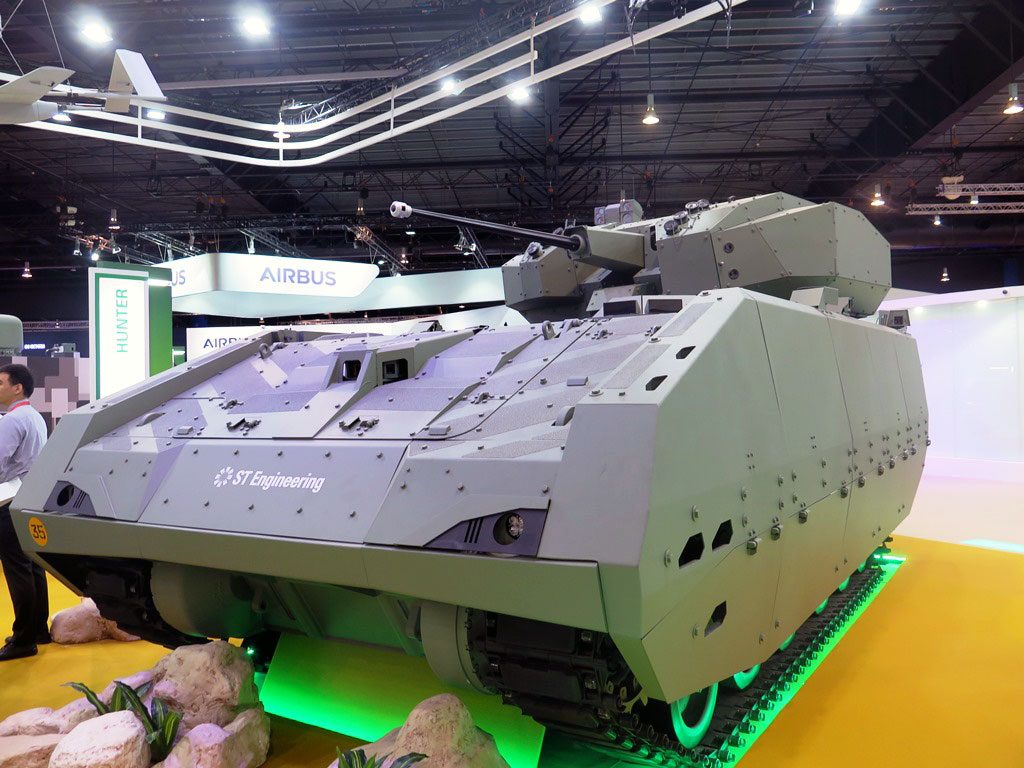
The Hunter is fitted with InArm hydro-pneumatic suspensions provided by Horstman of the UK, the company having recently been acquired by Renk AG of Germany. Adopting this solution allows getting rid of torsion bars and minimise road arm penetration into the vehicle hull. InArm suspensions use high-pressure nitrogen gas and an integral oil damper, all of them being contained within the road arm, which allows reducing weight and space compared to other solutions. Moreover they provide a growth path to advanced variable damping, lock-out and ride height management systems.
The vehicles delivered to Singapore are fitted with steel tracks, however according to ST Engineering rubber tracks can be adopted should a customer require it, a move that would reduce weight by about 1 tonne as well as vibrations, improving comfort and reducing wear and tear of vetronics.
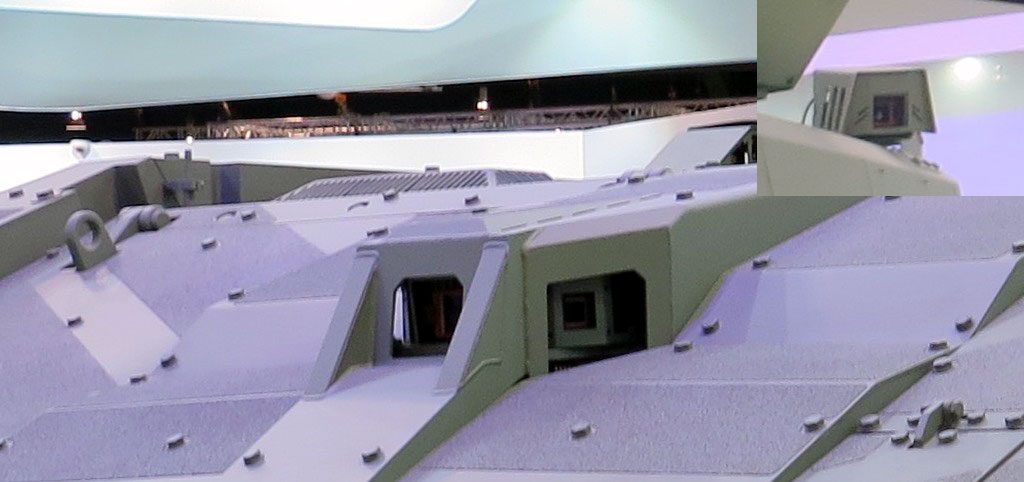
The Hunter can reach a maximum speed on road of 70 km/h, its road range being 500 km, specific fuel consumption being 227 g/kWh at 2,300 rpm. It can cope with 60% gradients, can overcome 0.6 meters vertical obstacles and cross a ditch 2.1 meters wide. The driver seat is located forward left, vision being provided by a front camera, two side cameras looking forward and a rear camera, images being shown on the driver’s screens. Side cameras are used for obstacle avoidance as well as for narrow crossing, optical periscopes being considered only backup systems. This allows to operate with hatch closed while maintaining full situational awareness, which was not the case when relying on periscopes. A 360° all-round close range observation and surveillance system is also installed.
No data are available on protection levels; the Hunter is clearly fitted with modular ballistic protection packages, as well as with underbelly protection against mines and IEDs, mine-blast resistant seats being provided to the three crew members and the eight dismounts in the rear. According to ST Engineering the Hunter’s vetronic architecture allows integrating third parties active protection systems.
The Hunter is fitted with the SuperneT VICS (Vehicular Integrated Communications System) crew station, provided by the electronic branch of ST Engineering, that provides the open architecture allowing to easy integrate subsystems, among which the tactical digital network and the high-speed network for mission-critical communications. The vehicle is fitted with the ARTEMIS (Army Tactical Engagement and Information System) that allows full data exchange with the other Army digitised vehicles, namely the Leopard 2SG and the Bionix II IFV. ARTEMIS also allows digitised planning from platoon up to battalion level, target handover with other elements, and also ensures HUMS (Health and Utilisation Monitoring System) functions easing maintenance operations.
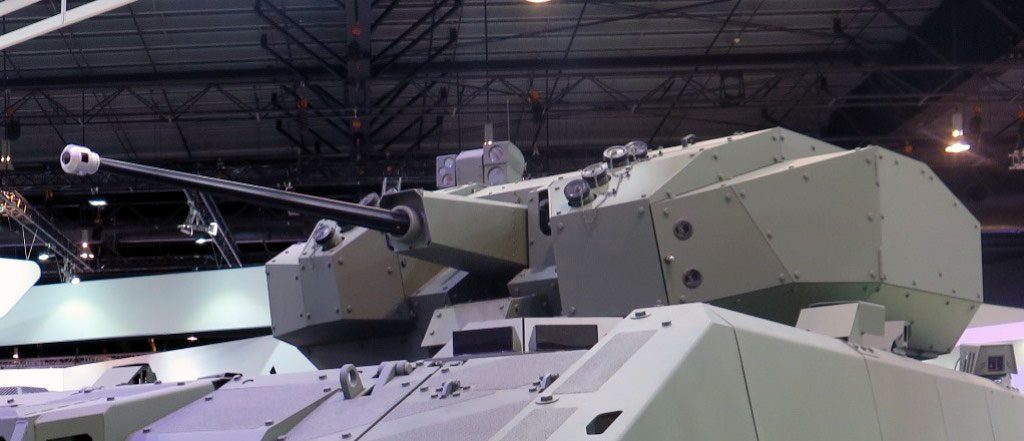
The lethality module, that is the turret, has been selected by the customer, the Singapore Army, the ST Engineering task being of integrating it in the vehicle. The choice went to a customised version of the Samson Mk II remotely controlled turret, designed and produced by Rafael of Israel. The main weapon is the Mk 44 Bushmaster II automatic cannon designed and produced by ATK, now part of Northrop Grumman, which fires 30×173 mm ammunition, 200 of which are hosted in the turret. A coaxial 7.62 mm machine gun is fitted on the right side of the main gun, the commanders independent panoramic side being also on the right, on top of the turret. Two series of four grenade launchers are fitted either side of the cannon, nearly embedded in the armour. Antitank vehicles will have their turret fitted with a missile launcher, hosting two Rafael Spike missiles.
Singapore Army mechanised battalion will also receive the recovery and the command and control variants of the Hunter IFV; the prototype of the former one has already been seen, although how much the production vehicle will differ is still to be seen, while ST Engineering stated that the work on the command version is ongoing.
To answer the Mobile Protected Firepower programme in the United States ST Engineering teamed with John Cockerill Defence offering the Hunter fitted with the Cockerill 3105 turret armed with the 105mm gun from the same company. The light tank has a crew of three, its combat weight being of 32.5 tonnes, which decreases the power-to-weight ratio to 21.8 hp/tonne. With gun forward the length goes up to 8.4 meters, the height above turret being of 3.5 meters. How much this version might be of interest for Singapore is unclear, however ST Engineering is looking at the export market, similar solutions having already been adopted by Asian armies. No ambulance version will be produced for Singapore, this role is devoted to the Bronco 3, while no interest for an engineer version has yet surfaced. The Hunter chassis might well be the basis for an air defence vehicle, but here too no firm indication has yet been expressed.
Born from the cooperation between ST Engineering and the MoD Defence Science and Technology Agency (DSTA) the Hunter will soon become operational with the first mechanised battalion of the Singapore Army, allowing the M113 to take a well deserved retirement.
Photos by Joseph Roukoz

